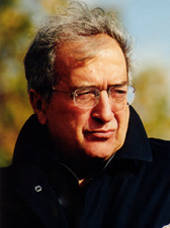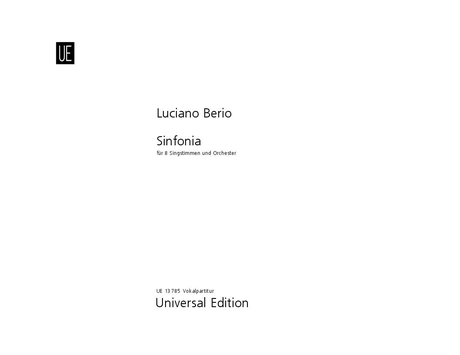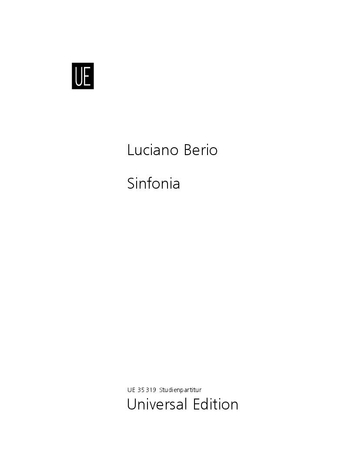

Luciano Berio
Sinfonia
Short instrumentation: 4 3 4 3 - 4 4 3 1 - perc(3), hp, e.hpsd, pno, e.org, alto sax, t.sax, str
Duration: 35'
Text von: Samuel Beckett, Luciano Berio, Claude Lévi-Strauss
Dedication: dedicated to Leonard Bernstein
Solos:
soprano
alto
tenor
bass
Instrumentation details:
piccolo
1st flute
2nd flute
3rd flute
1st oboe
2nd oboe
cor anglais
clarinet in Eb
1st clarinet in Bb
2nd clarinet in Bb
3rd clarinet in Bb
alto saxophone in Eb
tenor saxophone in Bb
1st bassoon
2nd bassoon
contrabassoon
1st horn in F
2nd horn in F
3rd horn in F
4th horn in F
1st trumpet in C
2nd trumpet in C
3rd trumpet in C
4th trumpet in C
1st trombone
2nd trombone
3rd trombone
bass tuba
1st percussion
2nd percussion
3rd percussion
harp
electric harpsichoird
piano
electric organ
violin A (8)
violin B (8)
violin C (8)
viola (8)
violoncello (8)
contrabass (8)
Berio - Sinfonia for 8 voices and orchestra
Printed/Digital
Translation, reprints and more

Luciano Berio
Berio: SinfoniaOrchestration: für 8 Singstimmen und Orchester
Type: Vokalpartitur (Sonderanfertigung)

Luciano Berio
Berio: SinfoniaOrchestration: für 8 Singstimmen und Orchester
Type: Dirigierpartitur (Sonderanfertigung)

Luciano Berio
Berio: Sinfonia for 2 soprano, 2 alto, 2 tenor and 2 bass soloists and orchestraOrchestration: for 2 soprano, 2 alto, 2 tenor and 2 bass soloists and orchestra
Type: Partitur (Sonderanfertigung)
Print-On-Demand

Luciano Berio
Berio: Sinfonia for 8 voices (SSAATTBB) and orchestraOrchestration: for 8 voices (SSAATTBB) and orchestra
Type: Studienpartitur
Sample pages
Audio preview
Work introduction
Luciano Berio on Sinfonia
The title of Sinfonia (composed in 1968 for the 125th anniversary of the New York Philharmonic Orchestra) is not meant to suggest any analogy with the classical symphonic form. It is intended more etymologically: the simultaneous sound of various parts, here eight voices and instruments. Or it may be taken in a more general sense as the interplay of a variety of things, situations and meanings. Indeed, the musical development of Sinfonia is constantly and strongly conditioned by the search for balance, often an identity between voices and instruments; between the spoken or the sung word and the sound structure as a whole. This is why the perception and intelligibility of the text are never taken as read, but on the contrary are integrally related to the composition. Thus, the various degrees of intelligibility of the text along with the hearer’s experience of almost failing to understand, must be seen to be essential to the very nature of the musical process.
The text of the first part is made up of a series of extremely short extracts from Claude Lévi-Strauss’s Le cru et le cuit, and one or two other sources. In these passages, Lévi-Strauss analyses the structure and symbolism of Brazilian myths of the origin of water, or other similarly structured myths.
The second part of Sinfonia is a tribute to the memory of Martin Luther King. The eight voices simply send back and forth to each other the sounds that make up the name of the Black martyr, until they at last state his name clearly and intelligibly. The main text of the third part is made up of fragments from Samuel Beckett’s The Unnamable, which in turn generate a large number of references and quotations from day-to-day life.
The text of the fourth part mimes rather than enunciates verbal fragments drawn from the preceding parts (with, at the beginning, a brief reference to Mahler’s Second Symphony.)
Finally, the text of the fifth part takes up, develops and complements the texts of the earlier parts, and above all gives these fragments narrative substance (being drawn from Le cru et le cui), whereas in the first pat they were presented merely as narrative images.
The third part of Sinfonia calls for more detailed comment, since it is perhaps the most experimental work I have ever written. The piece is a tribute to Gustav Mahler (whose work sometimes seems to carry all the weight of the last two centuries of musical history) and, in particular, to the third movement of his Second Symphony (“Resurrection”). Mahler bears the same relation to the whole of the music of this part as Beckett does to the text. The result is a kind of “voyage to Cythera” that reaches its climax just before the third movement (the Scherzo) of the Second Symphony. Mahler’s movement is treated as a generative and containing source, from which are derived a great number of musical figures ranging from Bach to Schoenberg, Beethoven to Stravinsky, Berg to Webern, Boulez, Pousseur, myself and others. The various musical characters, constantly integrated in the flow of Mahler’s discourse, are combined together and transformed as they go.
In this way, these familiar objects and faces, set in new perspective, context and light, unexpectedly take on a new meaning. The combination and unification of musical characters that are often foreign to each other is probably the main driving force behind this third part of Sinfonia, a meditation on a Mahlerian objet trouvé.
If I were asked to explain the presence of Mahler’s Scherzo in Sinfonia, the image that would naturally spring to mind would be that of a river running through a constantly-changing landscape, disappearing from time to time underground, only to emerge later totally transformed. Its course is at times perfectly apparent, at others hard to perceive, sometimes it takes on a totally recognizable form, at others it is made up of a multitude of tiny details lost in the surrounding forest of musical presences.
The first four parts of Sinfonia are obviously very different one from the other. The task of the fifth and last pat is to delete these differences and bring to light and develop the latent unity of the preceding four parts. In fact the development that began in the first part reaches its conclusion here, and it is here that all the other parts of the work flow together, either as fragments (third and fourth parts) or as a whole (the second). Thus this fifth part may be considered to be the veritable analysis of Sinfonia, but carried out through the language and medium of the composition itself.
Translated by John Underwood
